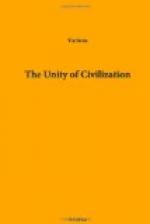The ‘human family’ then seems re-established as something more than a platform phrase; and separatists (who are always with us) have had to fall back upon another criterion of disunity.
THE UNITY OF MANKIND AS A RATIONAL ANIMAL
Omitting language for a moment (which since first telling of the ’Tower of Babel’ story has somewhat fallen from grace as a symptom of unity among mankind), or rather, subsuming it as one of the most essential exhibitions of rationality, and indeed its chief instrument, we come to Man’s unity as a creature possessed of reason, and expressing this reasoning habit in specific modes of living, under whatever external surroundings. These being almost infinitely various, it is not always easy to compare examples of Man’s reaction to them. For proof of the uniformity of human reasoning, indeed, we have to begin almost from an animal plane. ’Hath not a Jew eyes? Hath not a Jew hands, organs, dimensions, senses, affections, passions? Fed with the same food, subject to the same diseases, healed by the same means, warmed and cooled by the same summer and winter, as a Christian is?’ And not only is men’s hunger, and their sensitiveness to ‘the same summer and winter’ similar: their ways of satisfying hunger, their conduct of the food-quest, their elementary organizations ’for the sake of maintaining life’, as Aristotle expressed it, exhibit one mental type throughout. In the domestication of nature’s gifts it is the same: in the fashioning of implements and weapons, the improvisation of clothing and shelter, the almost instinctive impulse to ‘play with fire’ which repels other animals. Style and finish may vary, and do vary widely from one province of culture to another; but in their last mechanical analysis, a spade is a spade all the world over, and a celt a celt.
It was the service of the late General Pitt-Rivers in this country, and of Klemm more laboriously abroad, to establish this aspect of the ‘Evolution of Culture’ beyond controversy: as it was the work of Boucher de Perthes, and of Sir John Evans and Sir John Lubbock to proceed in the reverse direction, from a criterion of utility to a hypothesis of design, and the conclusion that certain stones, of reputedly prehuman antiquity, must be the work of human hands, geared to human brains like ours. Tylor’s wider range of observation, conspicuously supplemented by other work of Lubbock, embraced all human activities in one formula of comparison, which is indeed as old as Thucydides.[4] We can infer, that is, something about early stages of an advanced culture from the present-day practices of savagery.




